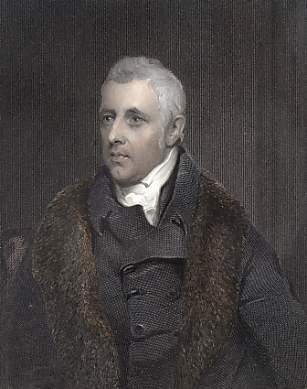
Dudley Ryder, 1st Earl of Harrowby, PC, FSA was a prominent British politician of the Pittite faction and the Tory party.

Earl of Harrowby, in the County of Lincoln, is a title in the Peerage of the United Kingdom. It was created in 1809 for the prominent politician and former Foreign Secretary, Dudley Ryder, 2nd Baron Harrowby. He was made Viscount Sandon, of Sandon in the County of Stafford, at the same time, which title is used as a courtesy title by the heir apparent to the earldom. His son, the second Earl, held office under Lord Palmerston as Chancellor of the Duchy of Lancaster and Lord Privy Seal. He was succeeded by his eldest son, the third Earl. He was a Conservative politician and notably served as President of the Board of Trade from 1878 to 1880.

William Eliot, 2nd Earl of St Germans, known as William Elliot until 1823, was a British diplomat and politician.

Dudley Ryder, 2nd Earl of Harrowby, KG, PC, FRS, styled Viscount Sandon between 1809 and 1847, was a British politician. He held office under Lord Palmerston as Chancellor of the Duchy of Lancaster in 1855 and as Lord Privy Seal between 1855 and 1858.
Hugh Aston was an English composer of the early Tudor period. While little of his music survives, he is notable for his innovative keyboard and church music writing. He was also politically active, a mayor, Member of Parliament, and Alderman.
Dudley Danvers Granville Coutts Ryder, 7th Earl of Harrowby, TD was a deputy chairman of Coutts bank and its parent company, NatWest. He was a descendant of Thomas Coutts, who joined the bank in 1761, and of Sir Dudley Ryder, Lord Chief Justice of the King's Bench in the 1750s. He was known by his courtesy title of Viscount Sandon from 1956 to 1987, when he succeeded to the title of Earl of Harrowby upon the death of his father, the 6th Earl.
Dudley Adrian Conroy Ryder, 8th Earl of Harrowby, DL is a British peer. He was known by the courtesy title of Viscount Sandon from 1987 until 2007.
William Emes was an English landscape gardener.
John Herbert Dudley Ryder, 5th Earl of Harrowby, briefly known as Viscount Sandon from March to December 1900, was a British peer and Conservative Member of Parliament. Harrowby was the son of Henry Dudley Ryder, 4th Earl of Harrowby, and Susan Juliana Maria Hamilton Dent.
Dudley Ryder, 6th Earl of Harrowby, known as Viscount Sandon from 1900 to 1956, was a British peer and Conservative Member of Parliament.

Sandon is a village in the civil parish of Sandon and Burston, in the Stafford district, in the county of Staffordshire, England. It is about 4.5 miles (7 km) northeast of Stafford. The village is in the Trent Valley on the A51 road. On 6 September 1989 the parish was renamed from "Sandon" to "Sandon & Burston".

Richard Brooke or Broke bought the manor of Norton, near Runcorn, Cheshire from Henry VIII in 1545 following the dissolution of the monasteries. The manor included the former monastery of Norton Priory and also the settlements of Norton, Stockham, Acton Grange and Aston Grange in Cheshire and Cuerdley in Lancashire.
William Hay, 17th Earl of Erroll, known as Lord Hay until 1778, was a Scottish peer.

John Braithwaite, the younger, was an English engineer who invented the first steam fire engine. He also co-designed the first locomotive claimed to have covered a mile in less than a minute.

Sandon Hall is a 19th-century country mansion, the seat of the Earl of Harrowby, at Sandon, Staffordshire, 5 miles (8.0 km) northeast of Stafford. It is a Grade II* listed building set in 400 acres (1.6 km2) of parkland.

Grantley Hall is a Country house located in North Yorkshire, England. It is situated near Grantley, about 5 miles (8 km) to the west of Ripon, on the banks of the River Skell. It is listed Grade II* on the National Heritage List for England, and the Japanese garden at the hall is listed Grade II on the Register of Historic Parks and Gardens.

Burnt Norton is the first poem of T. S. Eliot's Four Quartets. He created it while working on his play Murder in the Cathedral, and it was first published in his Collected Poems 1909–1935 (1936). The poem's title refers to the manor house Eliot visited with Emily Hale in the Cotswolds. The manor's garden serves as an important image within the poem. Structurally, the poem is based on Eliot's The Waste Land, with passages of the poem related to those excised from Murder in the Cathedral.

Henry Reginald Courtenay (1741–1803) was an English Bishop of Bristol (1794–1797) and Bishop of Exeter 1797–1803.
Francis Page was a British politician who sat in the House of Commons for 33 years from 1768 to 1801.
Sir William Keyt, 3rd Baronet of Norton House, Gloucestershire, was a British landowner and politician who sat in the House of Commons from 1722 to 1735. He died at his house in a catastrophic fire of his own creation and the garden which remained, and was restored, gave rise to the poem Burnt Norton by T. S. Eliot.












